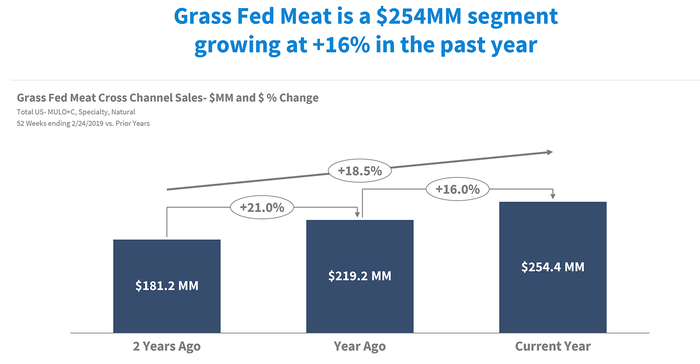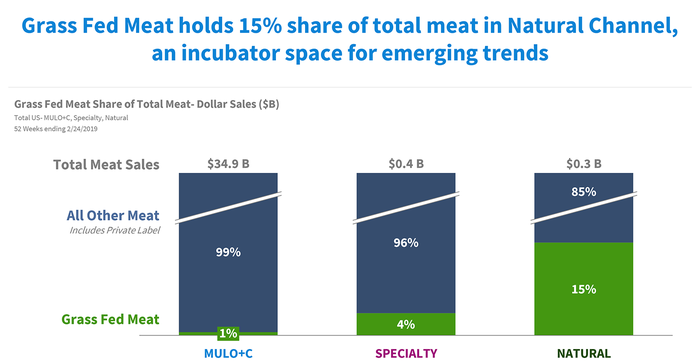Grazing in the grass is growing fast
This piece is part of the the Good Food Insights series—a collaboration with FamilyFarmed, its Good Food Accelerator, Esca Bona and SPINS—that unpacks the dynamics driving the good food movement.

Grass-fed and/or pasture-raised meat remains a very small segment of the overall U.S. consumer market. But that may not be true for long, as grass-fed meat sales are growing at an exceptional pace.
The retail market for grass-fed rose by 16 percent over the 52 weeks ending Feb. 24, 2019, according to SPINS, the leading consumer insights provider for the natural products industry. This is on top of a 21 percent increase over the prior 52 weeks.
According to SPINS, grass-fed now makes up 15 percent of meat sales in retail outlets that are part of the natural channel, compared to 1 percent in the multi-outlet channel (MULO, also generally known as conventional). But the well-established history of the natural channel as a proving ground for consumer grocery trends suggests that MULO number is heading up.
“We view the natural channel as the innovation channel, the canary in the coal mine, so to speak, of where the industry is going. Grass-fed is still relatively small. I think we will continue to see a proliferation of grass-fed into other channels, especially with these fast growth rates,” said Alice Mintz, senior manager of SPINS’ Strategic Partner Group.

Mintz also noted the most overt sign that conventional producers are recognizing the market potential of grass-fed: They are buying up some of the early wave of grass-fed meat companies. Perdue Farms was ahead of this curve, buying Coleman Natural Foods in 2011 and Niman Ranch in 2015. Applegate Farms was purchased by Hormel in 2015; General Mills absorbed Epic Provisions the next year.
Epic was at the cutting edge of the meat snack bar trend driven by protein-conscious consumers, and this was actually the fastest growing product segment in SPINS’ study of the grass-fed market. Sales of shelf-stable meat snacks (other than traditional jerky) rocketed by 48 percent over that 52-week period ending Feb. 24; burgers followed at 20 percent growth followed by beef and pork cuts (16 percent) and jerky (14 percent).
In real dollars, SPINS calculates that the U.S. retail market for grass-fed meats totaled $254 million over the course of the year measured. Mintz acknowledged, though, that this number is the tri-tip of the iceberg, because an even bigger percentage of the grass-fed meat produced is sold through specialty grocers and butcher shops, direct marketing (mostly farmers markets, CSAs and e-commerce) and restaurants/foodservice.
In fact, butchers and direct marketers are the primary sources of grass-fed meat for many in the “Know Your Farmer, Know Your Food” constituency of True Believers who are fueling the rapid growth of the good food movement. “Buying from these smaller retailers or specialty butcher shops is more of an assertion that you are getting high-quality meat,” Mintz said.

A menu of reasons
There is no one simple answer for why grass-fed meat is in increasing demand. We surveyed the owners of livestock farms that participated in FamilyFarmed’s 2019 Good Food EXPO in Chicago and received a range of opinions.
Cliff McConville owns All Grass Farms in the outer Chicago suburb of Dundee. He says his hundreds of customers run the gamut of consumer interests.
“I would say the No. 1 reason is health and nutrition, many people ... know that eating better-quality meats, dairy and eggs is better for them,” said McConville, who works for the interests of local small farms as chairman of the Chicagoland Band of Farmers coalition. “Others are very focused on animal welfare; in fact, we have many converted vegans and vegetarians who would not eat conventionally raised meats but will only eat meat from our farm.”
He continued, “There is also a strong contingent of ‘foodies’ who are focused on the highest quality, freshest, tastiest meats, eggs and dairy, and that is their main focus. And a few that are focused on the environmental benefits of our farming methods.”
For Mark Brady and Katie Kennedy of Timberfeast—located in Chatsworth, Illinois, about 100 miles southwest of downtown Chicago—meat from grass-fed, pastured livestock appeals to three leading interests among consumers in this space: taste, animal welfare and sustainability.
“When you get back to basics and strip away all the fancy marketing terms, we’re just doing what humans have done for ages—raising food grown from the earth. There’s an inner knowing that tells you this is the right way,” Brady and Kennedy said in a written answer.
They continued, “People are waking up to this truth: Animals raised in confinement operations are not the answer to any of the questions of animal welfare, taste or sustainability. The fresh grass and bugs add nuanced flavor and better nutrition to our products.”
Mike Biver co-owns Terra Vitae Farms in Woodstock, Illinois, about 65 miles northwest of Chicago, with his wife and in-laws; Katie Kelley, his mother-in-law, is a nutritionist. They believe a diet of plants on pasture produces “better for you” meat, and list health as the main reason they started the livestock operation in 2016.
“We focus on producing the healthiest meat conceivably possible by investing in biodiversity of plant life (the animals' diet) and frequent rotation of animals through pasture,” Biver said. “With our hyper-focus on the health of the animal, we end up producing the most nutrient dense, satiating meat people have ever tried.”
He continued that “good for people” is inextricably linked to “good for the Earth,” saying, “I can confidently state that if the environment is not being continually improved by your animal management practices, the meat you are producing is not the healthiest it can or should be. While we did not set out to save the planet, it is a lovely outcome of focusing on the producing the healthiest meat possible.”
And while much of the rising discussion about regenerative agriculture focuses on best practices in growing market and cover crops to improve soil health, these eco-conscious livestock producers also tied their work to regenerative principles.
“For a farm to be truly sustainable and regenerative, it needs livestock,” said Paul and Marisa Maggio, who gave up city life in Chicago to raise grass-fed beef cattle in Burlington, Wisconsin (about 70 miles northwest). “Our animals harvest our grasses and fertilize our land with their urine and manure, leaving us with no need to use synthetic chemical fertilizers, which are very energy intensive to produce. Animals make a farm a closed system.”

The satiating quality ascribed by Biver and others to grass-fed and pasture-raised meat also is seen as a way of alleviating the cost differential of these products, which tend to be more expensive than conventionally produced meats. Rob Levitt, one of Chicago’s leading whole animal butchers, promotes the idea of eating less meat, but better meat.
“If you get something that’s really high quality and you eat less of it, you are eating an appropriate portion size, and you also feel sated, you feel better. You’re satisfied by the savory quality of the meat and the sort of richness, the beefy flavor. Everything that you needed 27 ounces to get [in a conventionally produced steak], you can get in a 4- to 6-ounce portion,” said Levitt, who recently left The Butcher & Larder at the Local Foods retail store in Chicago (which he founded) for Publican Quality Meats, part of the One Off Hospitality Group co-owned by famed Chef Paul Kahan.
Whatever the reason each individual consumer wants grass-fed meats, the trends strongly suggest that they are going to keep wanting more of it.
Good Food Insights is an editorial partnership of New Hope Network’s Esca Bona thought-leadership platform; FamilyFarmed’s Good Food Accelerator; and SPINS, the leading wellness-focused data technology company for the natural, organic and specialty products industry. Good Food Insights articles provide timely analysis of major trends and innovation in the national good food landscape.
About the Author(s)
You May Also Like




